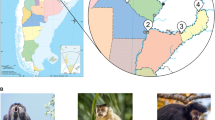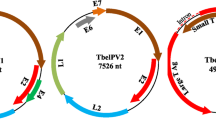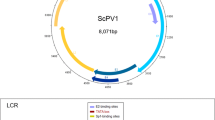Abstract
Papillomaviruses (PVs) are host-species-specific and tissue-specific viruses that infect a diverse array of vertebrate hosts, including humans and non-human primates, with varying pathogenic outcomes. Although primate PVs have been studied extensively, no complete genome sequences of PVs from lemurs have been determined to date. Saliva samples from three critically endangered, captive black-and-white ruffed lemurs (Varecia variegata variegata) at the Duke Lemur Center (USA) were analyzed, using high-throughput sequencing, for the presence of oral papillomaviruses. We identified three PVs from two individuals, one of which had a coinfection with two different PVs. Two of the three PVs share 99.6% nucleotide sequence identity, and we have named these isolates "Varecia variegata papillomavirus 1" (VavPV1). The third PV shares ~63% nucleotide sequence identity with VavPV1, and thus, we have named it "Varecia variegata papillomavirus 2" (VavPV2). Based on their E1 + E2 + L1 protein sequence phylogeny, the VavPVs form a distinct clade. This clade likely represents a novel genus, with VavPV1 and VavPV2 belonging to two distinct species. Our findings represent the first complete genome sequences of PVs found in lemuriform primates, with their presence suggesting the potential existence of diverse PVs across the over 100 species of lemurs.


Similar content being viewed by others
Data availability
The sequences described in this study have been deposited in the GenBank database under accession numbers OP376964-OP376966. Raw reads have been deposited at SRA under BioProject: PRJNA874427; BioSample: SAMN30547858; SAMN30547860; SRA: SRR21284443; SRR21284444.
References
Silvestre RV, de Souza AJ, Junior EC, Silva AK, de Mello WA, Nunes MR, Junior JL, Cardoso JF, de Vasconcelos JM, de Oliveira LF, da Silva SP, da Silva AM, Fries BG, Summa ME, de Sa LR (2016) First new world primate Papillomavirus identification in the Atlantic Forest, Brazil: Alouatta guariba papillomavirus 1. Genome Announc 4:e00725-e816
Joh J, Hopper K, Van Doorslaer K, Sundberg JP, Jenson AB, Ghim SJ (2009) Macaca fascicularis papillomavirus type 1: a non-human primate betapapillomavirus causing rapidly progressive hand and foot papillomatosis. J Gen Virol 90:987–994
Van Doorslaer K, Chen Z, Bernard HU, Chan PKS, DeSalle R, Dillner J, Forslund O, Haga T, McBride AA, Villa LL, Burk RD, Ictv Report C (2018) ICTV virus taxonomy profile: papillomaviridae. J Gen Virol 99:989–990
Chen Z, Long T, Wong PY, Ho WCS, Burk RD, Chan PKS (2019) Non-human primate papillomaviruses share similar evolutionary histories and niche adaptation as the human counterparts. Front Microbiol 10:2093
Buck CB, Day PM, Trus BL (2013) The papillomavirus major capsid protein L1. Virology 445:169–174
Wang JW, Roden RB (2013) L2, the minor capsid protein of papillomavirus. Virology 445:175–186
Middleton K, Peh W, Southern S, Griffin H, Sotlar K, Nakahara T, El-Sherif A, Morris L, Seth R, Hibma M, Jenkins D, Lambert P, Coleman N, Doorbar J (2003) Organization of human papillomavirus productive cycle during neoplastic progression provides a basis for selection of diagnostic markers. J Virol 77:10186–10201
Bergvall M, Melendy T, Archambault J (2013) The E1 proteins. Virology 445:35–56
McBride AA (2013) The papillomavirus E2 proteins. Virology 445:57–79
Roman A, Munger K (2013) The papillomavirus E7 proteins. Virology 445:138–168
Vande Pol SB, Klingelhutz AJ (2013) Papillomavirus E6 oncoproteins. Virology 445:115–137
Long T, Burk RD, Chan PKS, Chen Z (2022) Non-human primate papillomavirus E6-mediated p53 degradation reveals ancient evolutionary adaptation of carcinogenic phenotype to host niche. PLoS Pathog 18:e1010444
Van Doorslaer K, Li Z, Xirasagar S, Maes P, Kaminsky D, Liou D, Sun Q, Kaur R, Huyen Y, McBride AA (2017) The Papillomavirus Episteme: a major update to the papillomavirus sequence database. Nucleic Acids Res 45:D499–D506
Rector A, Van Ranst M (2013) Animal papillomaviruses. Virology 445:213–223
Bergin IL, Bell JD, Chen Z, Zochowski MK, Chai D, Schmidt K, Culmer DL, Aronoff DM, Patton DL, Mwenda JM, Wood CE, Burk RD (2013) Novel genital alphapapillomaviruses in baboons (Papio hamadryas Anubis) with cervical dysplasia. Vet Pathol 50:200–208
Chen Z, van Doorslaer K, DeSalle R, Wood CE, Kaplan JR, Wagner JD, Burk RD (2009) Genomic diversity and interspecies host infection of alpha12 Macaca fascicularis papillomaviruses (MfPVs). Virology 393:304–310
Antonsson A, Hansson BGR (2002) Healthy skin of many animal species harbors papillomaviruses which are closely related to their human counterparts. J Virol 76:12537–12542
Hoffmann M, Schütze E, Bernhard A, Schlaphoff L, Kaul A, Schöniger S, Pöhlmann S (2019) Disease manifestation and viral sequences in a bonobo more than 30 years after papillomavirus infection. Pathogens 8:13
D’Arc M, Moreira FRR, Dias CA, Souza AR, Seuanez HN, Soares MA, Tavares MCH, Santos AFA (2020) The characterization of two novel neotropical primate papillomaviruses supports the ancient within-species diversity model. Virus Evol 6:veaa036
Barrett MA, Brown JL, Junge RE, Yoder AD (2013) Climate change, predictive modeling and lemur health: assessing impacts of changing climate on health and conservation in Madagascar. Biol Cons 157:409–422
Bolger AM, Lohse M, Usadel B (2014) Trimmomatic: a flexible trimmer for Illumina sequence data. Bioinformatics 30:2114–2120
Li D, Liu C-M, Luo R, Sadakane K, Lam T-W (2015) MEGAHIT: an ultra-fast single-node solution for large and complex metagenomics assembly via succinct de Bruijn graph. Bioinformatics 31:1674–1676
Buchfink B, Xie C, Huson DH (2015) Fast and sensitive protein alignment using DIAMOND. Nat Methods 12:59–60
Altschul SF, Gish W, Miller W, Myers EW, Lipman DJ (1990) Basic local alignment search tool. J Mol Biol 215:403–410
Bushnell B (2014) BBMap: a fast, accurate, splice-aware aligner. Lawrence Berkeley National Lab (LBNL), Berkeley
Tisza MJ, Belford AK, Dominguez-Huerta G, Bolduc B, Buck CB (2021) Cenote-Taker 2 democratizes virus discovery and sequence annotation. Virus Evol 7:veaa100
Bernard HU, Burk RD, Chen Z, van Doorslaer K, zur Hausen H, de Villiers EM (2010) Classification of papillomaviruses (PVs) based on 189 PV types and proposal of taxonomic amendments. Virology 401:70–79
Muhire BM, Varsani A, Martin DP (2014) SDT: a virus classification tool based on pairwise sequence alignment and identity calculation. PLoS ONE 9:e108277
Katoh K, Standley DM (2013) MAFFT multiple sequence alignment software version 7: improvements in performance and usability. Mol Biol Evol 30:772–780
Capella-Gutierrez S, Silla-Martinez JM, Gabaldon T (2009) trimAl: a tool for automated alignment trimming in large-scale phylogenetic analyses. Bioinformatics 25:1972–1973
Darriba D, Taboada GL, Doallo R, Posada D (2011) ProtTest 3: fast selection of best-fit models of protein evolution. Bioinformatics 27:1164–1165
Minh BQ, Schmidt HA, Chernomor O, Schrempf D, Woodhams MD, von Haeseler A, Lanfear R (2020) IQ-TREE 2: new models and efficient methods for phylogenetic inference in the genomic era. Mol Biol Evol 37:1530–1534
Letunic I, Bork P (2021) Interactive Tree Of Life (iTOL) v5: an online tool for phylogenetic tree display and annotation. Nucleic Acids Res 49:W293–W296
Willemsen A, Bravo IG (2019) Origin and evolution of papillomavirus (onco)genes and genomes. Philos Trans R Soc Lond B Biol Sci 374:20180303
Acknowledgements
We particularly thank the Duke Lemur Center (DLC) staff members was scheduled and aided in sample collection. This is DLC publication #1530.
Funding
The work described here was supported by TriCEM (Triangle Center for Evolutionary Medicine), Duke Biology, and Sigma Xi grants awarded to ENP.
Author information
Authors and Affiliations
Corresponding authors
Ethics declarations
Conflict of interest
The authors declare no conflicts of interest.
Permits
Animal handling and sample collection protocols were approved by the Office of Animal Welfare Assurance at Duke University, USA (IACUC #A161-21-08).
Additional information
Handling Editor: Ana Cristina Bratanich.
Publisher's Note
Springer Nature remains neutral with regard to jurisdictional claims in published maps and institutional affiliations.
Rights and permissions
Springer Nature or its licensor (e.g. a society or other partner) holds exclusive rights to this article under a publishing agreement with the author(s) or other rightsholder(s); author self-archiving of the accepted manuscript version of this article is solely governed by the terms of such publishing agreement and applicable law.
About this article
Cite this article
Paietta, E.N., Kraberger, S., Custer, J.M. et al. Identification of diverse papillomaviruses in captive black-and-white ruffed lemurs (Varecia variegata). Arch Virol 168, 13 (2023). https://doi.org/10.1007/s00705-022-05679-1
Received:
Accepted:
Published:
DOI: https://doi.org/10.1007/s00705-022-05679-1




